explore
Andean Highlands - Politics
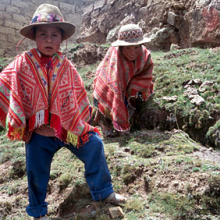
In the highlands, 1800 B.C. was an important time. A distinctly highland way of life developed then, and many aspects of life remain unchanged to highland peoples living in the region today. People's lives in highland society became dominated by farming and herding activities.
Highlanders domesticated llamas and alpacas, for beasts of burden and fine wool respectively. These animals thrive in the higher zones of the Andes called the puna. The bottom lands, in the sierra, were important for agriculture thanks to intensive irrigation. As early highlanders began to build, unite (or divide) as communities and exalt their leaders, their way of life became increasingly affected by politics.
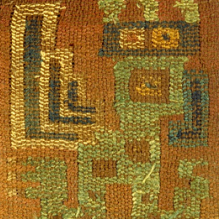
At three major points in Andean history, highland ideas and values were spread widely to other ancient Peruvian cultures and regions. In each case, dominant cultures greatly influenced the region as a whole (with ideas, war clubs or both). Those cultures, in chronological order, were: Chavín, Wari, Inka
Image: Detail, Wari textile fragment, c. A.D. 750-900. Transforming bird/man motif. T97.0006
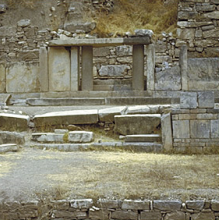
Chavín
Chavín de Huantar, located in the northern highlands, was a civic ceremonial centre founded by 800 B.C. It was the spiritual home to an oracle deity. As a religious centre, Chavín was an important destination for pilgrims from all over the Andean world. The artistic style of the Chavín people influenced many of its contemporaries, spreading as far as the southern coast. Never before in the Andes had a single culture demonstrated such an influence over such a wide territory.
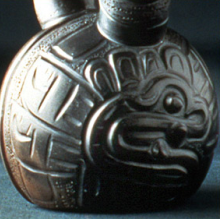
The armies of later cultures conquered other societies of the Andes. However, the spread of Chavín artistic influence seems to have been linked with the spread of their religious values, not their military might. Textiles displaying Chavín motifs were widely distributed, and were used by worshipers in Chavín rituals. As objects encoded with Chavín meanings and ideas spread among populations, so too did the art style and the materials used. Wool, a distinctly highland material, first began appearing in coastal textiles during the Chavín era.

Wari
The second cultural tradition to dominate the highlands and spread to other regions was the Wari. By A.D. 600, the Wari developed canals and terraces to help them farm the steep central highland slopes.
The artistic style of the Wari is quite distinctive. It spread far and wide through ancient Peru. On their textiles and ceramics, the Wari often depicted gods holding staffs. (Images of these staff-bearers may have originated at the southern highland site of Tiwanaku in Bolivia).
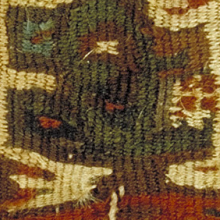
At the height of Wari influence around A.D. 600, textiles (especially woven tapestry) were the prime artistic medium, and were highly valued items indicating prestige. Typical were large tunics, crafted for imperial officials, and requiring a tremendous amount of time and skill to produce. Some of the most elaborate garments could have been made up of more than 10 km of thread, with weavers repeatedly interlocking various colours up to a million and a half times.
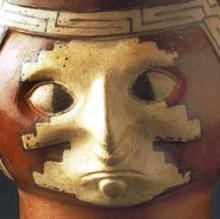
Ceramic designs were more conservative than textiles. The blocky, geometric presentation found in Wari art was also a product of tapestry weaving. When weaving textiles, people produce images in rectangular grids, and it is difficult to make non-rectangular shapes. The blocky style which originated in textiles was so dominant that it was reflected in the manner in which the Wari painted images on their ceramics.
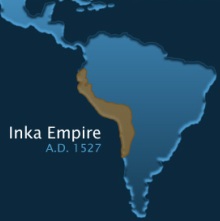
Inka
Around 1438, the powerful Inka people began a rise to supreme power that lasted less than one hundred years. In that short time, they conquered an empire almost as large as ancient Rome. The Inka empire spanned 5,500 km, and encompassed all of modern Peru and parts of Ecuador and Chile. It was the largest in the Americas before European contact. The Inka empire was called Tawantinsuyu (Land of the Four Quarters).
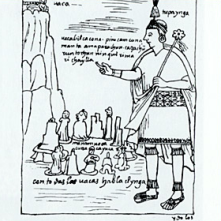
Originally, the Inka were but one of several groups competing for power in the central highlands around Cusco. The Inka rose to supremacy through a combination of superior military techniques and shrewd diplomacy. The Inka conquered every landscape and culture in the Andean region, keeping Cusco as the capital. The first great leader and empire founder was Pachakuti, followed by his son Topa Inka, and then grandson Wayna Capac.
Image: Illustration by Guaman Poma, a 17th century chronicler of life in Peru, depicting Topa Inka addressing idols at a highland rock shrine.
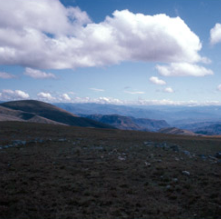
The Inka conquered the diverse peoples of the Andean region by sheer military might. To maintain control, they built an elaborate road system covering some 40,000 km, through all varieties of terrain, from jagged mountain slope to windswept desert.
Image: An abandoned segment of the Inka road system near Huamachuco in the North Highlands.
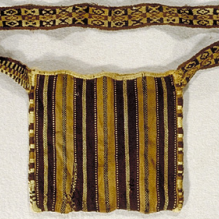
The Inka divided the empire into four parts, and established a bureaucracy to manage Inka rule. All aspects of life for the conquered subjects of the Inka soon revolved around increasing the power and wealth of the Inka empire. Subjects such as weavers, stone masons, potters, or farmers were required to pay up to two-thirds of their produce as a tax to the state. The empire remained very culturally diverse despite uniform political control over a wide range of peoples.
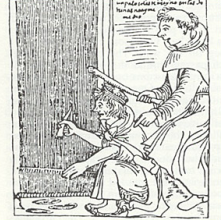
As impressive as it was, the Inka reign was short-lived. In 1532 the empire was sharply divided as heirs to the Inka throne quarreled over who would succeed Wayna Capac. In this political climate Francisco Pizarro and his Spanish conquistadors arrived. European diseases, which were completely foreign to indigenous immune systems, had been brought to Mexico a decade earlier. These diseases spread to the Andes before the conquistadors arrived. When the Spanish arrived with some 100 men, they took advantage of the divided political loyalties of the Inka, the vulnerabilities brought on by disease and the confusion their arrival generated and ultimately conquered Peru.